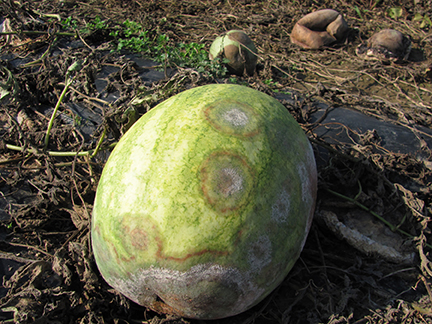Most growers first notice this disease when large, soft areas develop on mature watermelon fruit. These lesions can be several inches across and are often covered with a white mold. The lesions usually form first on the bottom of the fruit, close to where the fruit comes into contact with the soil. Further development of the disease often results in lesions on the top of the fruit as well (see Figure 1). Conditions that favor Phytophthora fruit rot include warm, rainy weather such as occurred recently over much of Indiana. Water that stands in pools also favors severe disease symptoms. Overhead irrigation may help the disease to spread. Phytophthora fruit rot can spread rapidly when conditions are favorable.
The organism that causes Phytophthora fruit rot of watermelon is Phytophthora capsici. This organism is more closely related to algae than to fungi. Therefore, P. capsici is sometimes referred to as a fungus-like organism. The close relationship of P. capsici to algae helps explain why this disease is favored by water; one of the life stages is a spore that is motile is water. Perhaps because of the taxonomic difference between P. capsici and most fungi, the fungicides that are most affective against P. capsici are less affective against most fungal diseases.
To control this disease, choose fields that are well drained, preferably fields that do not have a history of the disease. Watermelon fields with plastic mulch and raised beds may have less disease severity. Fungicides, if used, are best applied before the disease appears. This is because by the time a few lesions appear, many more lesions are present, but are too small to see. For the most part, growers will want to wait until fruit are present to apply fungicides. Applications to small fruit may include Forum® or one of the products with phosphorous acid as an active ingredient (e.g., Agri-Phos®, Phostrol®, Kphite®). However, during conducive conditions (such as rainy weather on fields with a history of the disease) Presidio® can be alternated with Revus®. A newer product, Zampro®, has also proven effective.
Be careful to alternate fungicide modes of action, or FRAC codes. For example, Revus® and Forum® both have 40 FRAC codes and should not be alternated with each other. Zampro® has two FRAC codes, 40 and 45, and therefore should not be alternated with Revus® or Forum®.
Phytophthora fruit rot of watermelon can be a serious disease. Prepare for this disease before it appears in a field near you.
This article was original published on the VeggieDiseaseBlog at https://veggiediseaseblog.org on June 23, 2015.
